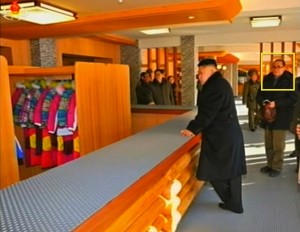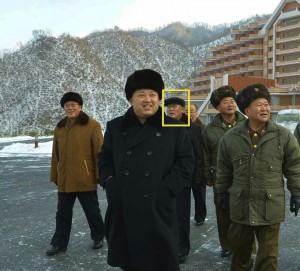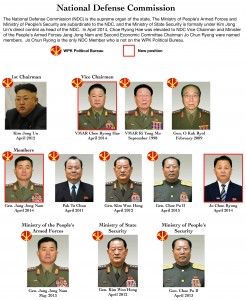The DPRK Political Season: Two Post-Mortems
North Korea kicked off its political calendar with a pair of meetings on April 8 and April 9, 2014. Continuing a standard practice of the Kim Il Sung Era, a meeting of the top leadership of the Workers’ Party of Korea (WPK) Central Committee occurred a day ahead of the opening session of the 13th Supreme People’s Assembly.[1]
The Political Bureau Meeting
The day before the opening session of the 13th Supreme People’s Assembly (SPA), the Workers’ Party of Korea (WPK) Political Bureau (Politburo) convened to discuss “the issue of reinforcing the organization for increasing the leadership role and function of the party as required by the developing revolution.” Of the two meetings held last week, the Political Bureau’s gathering was more important, but the North Koreans did not reveal much about what happened at the session, deferring all details until the SPA session the next day.
The session on April 8, 2014 was the first reported meeting of the Political Bureau since December 2013, when Jang Song Thaek was dismissed from office. The agenda included “a proposal for forming the state leadership body to be submitted” to the SPA meeting, a clear link between the WPK and its control over the affairs of state.
Also on the agenda was “an organizational matter” which involved changes to the membership of the Political Bureau itself. It is probable that General O Kuk Ryol was formally elevated to full membership and that Ju Kyu Chang was removed and replaced by Jo Ryun Chol. There may also have been personnel changes to the WPK Secretariat and the directors of WPK Central Committee Departments, most likely tied to the fallout from Jang Song Thaek’s dismissal. However, changes in the Central Committee were not disclosed in the media. Personnel changes on the Political Bureau and in the WPK Central Committee Departments will likely be made public at a future date during state events (when members of the Political Bureau are named or called-out in state media) and possibly when attendees are listed during Kim Jong Un’s onsite inspections and visits. Until then, Pyongyang-watchers can only speculate as to who is, and is not, in favor.
The 13th Supreme People’s Assembly
The SPA was the first major political event to occur under Kim Jong Un’s leadership. (It could be argued that all prior meetings of the SPA since Kim’s accession were remnants of the Kim Jong Il era, even though they contributed to Kim Jong Un establishing his leadership.)
Since the convocation of the 10th SPA in September 1998, the first session of every SPA meeting has been an occasion for the DPRK’s political leadership to promulgate legal changes, policy shifts and senior personnel appointments.[2] Moreover, the first session of the 13th SPA might have fulfilled that role as a venue for changes to the DPRK Constitution to redefine the roles of power organizations such as the National Defense Commission (NDC), the DPRK Cabinet or the State Planning Commission. While the 13th meeting provided Kim Jong Un with ample opportunities on all fronts, there were no major shifts or changes.
Pyongyang’s Power Quartet Still Stands
Contrary to rumors beforehand, there were no changes in the DPRK’s leading officials (the Suryong (Kim Jong Un), followed by the President of the SPA Presidium, the DPRK Premier and the Director of the Korean People’s Army (KPA) General Political Department).[3] SPA Presidium President Kim Yong Nam and DPRK Premier Pak Pong Ju kept their jobs, despite rumors in South Korean media that they would be dismissed from office. With Jang Song Thaek out of the way, Vice Marshal Choe Ryong Hae was elevated to Vice Chairman of the NDC. In purely cosmetic terms, Choe Ryong Hae has a similar position to that of the late Jo Myong Rok, the DPRK’s second-ranking official from 1998 to 2007. Choe will never enjoy the same amount of influence over Kim Jong Un that Jo Myong Rok had over Kim Jong Il,[4] but he now inhabits Jo’s former political offices.
Wither the National Defense Commission?
In April 2012, the NDC consisted of four Vice Chairmen and seven members. In April 2014, following the SPA meeting, the NDC now consists of three Vice Chairmen[5] and five members. One might view Vice Chairmen and Members[6] of the NDC as representing a specific organization or constituency (i.e. the Minister of the People’s Armed Forces, the Minister of State Security, the WPK Secretary for Machine-Building Industries, etc.). The lower number of NDC Vice Chairmen and Members shows that some institutional relationships and roles have been redefined. The arms industry slots on the NDC are now held by two individuals instead of three. The internal security agencies (State Security and People’s Security) are represented by single members. Moreover, with the removal from office and execution of Jang Song Thaek, internal security is no longer represented among the NDC’s Vice Chairmen; this shows control of the internal security apparatus has shifted to Kim Jong Un.
Vice Marshal Choe Ryong Hae, elevated from NDC Member to Vice Chairman, also holds concurrent positions as Vice Chairman of the Party Central Military Commission and member of the WPK Political Bureau Presidium, in addition to his day job as Director of the KPA General Political Department. With Choe’s elevation, following the dismissal and execution of Jang Song Thaek, all Vice Chairmen of the NDC are now uniformed members of the KPA high command. In the context of the KPA formal chain of command, a lack of a civilian (Jang had reserve or provisional military rank) subordinates the NDC Vice Chairmen under the KPA Supreme Commander (Kim Jong Un) and the Party Central Military Commission; having uniformed officers (Jang held a provisional or reserve KPA rank) at the top of the NDC, in lieu of a civilian, diminishes the possibilities of the kind of power grab of which Jang Song Thaek was accused.
The newest member of the NDC is Jo Chun Ryong, Chairman of the Second Economic Committee (SEC). Most recently a senior SEC official and former party cadre in the munitions and machine-building sector, Jo occupies the NDC slot held both by Paek Se Bong (immediate past chairman of the SEC) and Ju Kyu Chang, Director of the WPK Machine-Building Industry Department and an SEC Vice Chairman. Paek was removed as Chairman in 2013, while Ju’s status is not currently known. These shifts may reflect a generational change that has been unfolding since 2013 in organizations responsible for the production, research and development of conventional arms as well as weapons of mass destruction (WMD). With Jo’s appointment (and the removal of Paek and Ju) the NDC now has two representatives (Jo and Pak To Chun) from the arms production apparatus.
New Minister of Foreign Affairs
In the most notable personnel change at the SPA meeting, Ri Su Yong was appointed Foreign Minister. According to some accounts, Ri is also known as Ri Chol,[7] a classmate of late leader Kim Jong Il’s who served as the DPRK’s representative to the UN Mission in Geneva and Ambassador to Switzerland during the 1980s. Ri Chol is a surrogate father and mentor to Kim Jong Un and handled a number of personal and financial issues for Kim Jong Il. Under Kim Jong Il, the Foreign Minister was largely a figurehead with the real policymaking power belonging to the First Vice Minister. If (and this is a big if) Kim Jong Un has appointed a close confidante as Foreign Minister, then the nature of the position has been redefined, given to someone with enormous influence and substantive policymaking powers.


The appointment of Ri Su Yong should also be viewed in conjunction with the removal of Kang Sok Ju as Vice Premier. A seasoned, experienced negotiator with the United States and China over the North’s nuclear weapons, ballistic missile and nuclear energy programs, Kang was the late leader Kim Jong Il’s closest foreign policy aide and advisor who exercised de facto control over the Foreign Ministry as its First Vice Minister. According to KCNA report on April 13, Kang has now become a Party Secretary. Most likely he has replaced Kim Yong Il as secretary in charge of the Central Committee’s International Department (probably one of the personnel actions taken at the Political Bureau meeting on April 8.
Despite Aunt’s Absence, Kim Family Power Still in Place
Kim Kyong Hui, sister of the late leader Kim Jong Il and aunt of Kim Jong Un, was not observed to have attended either the Political Bureau meeting or SPA session. Nor has she made a public appearance since September 2013, leading some to argue that Kim Jong Un has downplayed the role of the Kim family in public life. However, the family remains represented in the current leadership line-up with Kim Il Sung’s youngest brother Kim Yong Ju[8] retaining his position as the Honorary Vice President of the SPA Presidium, and Vice Marshal Ri Yong Mu, Kim Jong Il and Kim Kyong Hui’s mother’s cousin, retained his position as NDC Vice Chairman.
New Minister of Atomic Energy
Ri Je Son, director the General Department of Atomic Energy, has successfully moved into the position of Minister. Until the mid-1990s, the DPRK had a Ministry of Atomic Energy that was later downgraded to a Cabinet-level department. In keeping with the WPK Central Committee’s (and Kim Jong Un’s) decision to emphasize the nuclear sector in March 2013, the atomic department was elevated back to a ministry the next month. However, its leading official was never identified, either due to political infighting over the ministerial appointment or to prevent having the officeholder from being subjected to sanctions. (During subsequent action, the UN Security Council sanctioned the Ministry and announced its intention to sanction the Minister once he or she was publicly named.) Ri’s appointment is no surprise since he has been the public face of the DPRK’s nuclear complex for at least a decade.
Shuffling Other Ministry Deck Chairs
Some tweaks to Cabinet ministries and state commissions may be tied to Kim Jong Un’s medium- and long-term economic policies, others to the demise of Jang. For example, it appears the Ministry of Light Industry has merged with the Ministry of Food and Consumer Goods Industries (formerly known as the Ministry of Foodstuffs and Daily Necessities). This consolidation appears to be an attempt to boost efficiency in the light industrial complex by removing redundant functions between Cabinet ministries.[9]
One change to a state commission may be fallout from Jang’s purge. It appears that the Capital City Construction Commission[10] has been disbanded, likely merged with Ministry of Urban Management or the Ministry of State Construction Control. When Jang appeared before a State Security tribunal, one of the charges leveled against him was that he “undermined the work system related to the construction of the capital city,” and “weakened the ranks of technicians and skilled workers at the unit for the construction of the capital city in a crafty manner and transferred major construction units to his confidants so that they might make money.”

For an additional breakdown of the SPA session, see “The SPA Session of April 2014: Spotlight on Sports and Economic and Trade Zones,” by Ruediger Frank.
[1] In 2012 (Kim Jong Un’s first year as supreme leader), the 4th Party Conference convened prior to the 5th session of the 12th Supreme People’s Assembly. In 2013, a plenary meeting of the WPK Central Committee occurred the day before the 7th session of the 12th Supreme People’s Assembly. This does not completely fit the sequence of the Kim Il Sung years when a Central Committee plenum was held prior to all SPA sessions. However, since 2012, with one exception, all SPA sessions have been preceded by a party meeting.
[2] For example at the first session of the 10th SPA, the DPRK Constitution was amended to establish the National Defense Commission as the ultimate authority in state power with the SPA Presidium President serving as the nominal head of state. The first session of the 11th SPA in September 2003 saw a number of senior personnel appointments in the DPRK Cabinet and NDC. The first session of the 12th SPA saw numerous amendments to the DPRK Constitution and the appointment of senior officials who would be tasked with crisis management and eventually facilitate the succession of Kim Jong Un.
[3] This quartet of senior officials holds the top spots in the WPK Political Bureau, as members of its Presidium (or standing committee). At state events at which they are all in attendance, they are mentioned first in the call-out order in state media broadcasts. With these positions comes an enormous amount of influence in terms of policymaking and patronage.
[4] When Kim Jong Il returned to North Korea in 1945 with his mother and younger brother, Jo Myong Rok literally carried the four-year old Kim Jong Il on his back.
[5] Eliminated entirely from the NDC apparatus is Vice Marshal Kim Yong Chun, who had served as NDC Vice Chairman since 2007. In April 2012, Kim was appointed Director of the WPK Civil Defense Department. His status in this position is not known at the present so it is possible Vice Marshal Kim may have retired.
[6] Note that one member of the high command not on the NDC is General Ri Yong Gil, Chief of the KPA General Staff. The head of the General Staff is generally not a member of the NDC.
[7] The man who served as the DPRK Ambassador to the UN Mission in Geneva and Ambassador to Switzerland introduced himself as Ri Chol when he met and worked with foreigners. He was also identified in DPRK state media accounts as Ri Chol when he greeted Orascom executive Naguib Sawiris at the Pyongyang Airport in January 2012 and was identified as Ri Chol in western media accounts covering his speeches at UN meetings in Geneva.
[8] Kim Yong Ju has made occasional public appearances in state media, despite being largely marginalized. Some Pyongyang watchers interpreted the 2013 appointment of Choe Yong Rim as Honorary SPA Vice President as replacing Kim, but that was not the case. He has held the position since September 1998. Kim Yong Ju’s family members (in-laws, nieces, nephews, etc.) are linked to various foreign trade activities. Kim also maintains ties to the side branches of the Kim family who live in virtual exile including Kim Pyong Il, who serves as DPRK Ambassador to Poland, niece Kim Kyong Chin, the wife of the DPRK Ambassador to Austria, and several other children fathered by Kim Il Sung that reside in central Europe and Scandinavia.
[9] DPRK Cabinet Ministries with economic functions control a series of what are called “complexes.” A “complex” consists of state-owned and semi-privatized factories, production sites, mines, farms, etc. In this case, consumer goods were split between the old Ministry of Light Industry and the Ministry of Food and Daily Necessities. With this change, the consumer goods and light industry complex is now concentrated in one ministry—the Ministry of Food and Consumer Goods.
[10] The Capital City Construction Commission was chaired by a Kim In Sik, who concurrently served as Vice Premier. Kim In Sik was not reappointed Vice Premier at during the opening session of the 13th SPA. He is a former Vice Minister of People’s Security, the DPRK’s national police and domestic intelligence agency, which Jang Song Thaek previously managed and to which he had close patronage ties.
See the second article on the leadership changes written by Ruediger Frank here.
